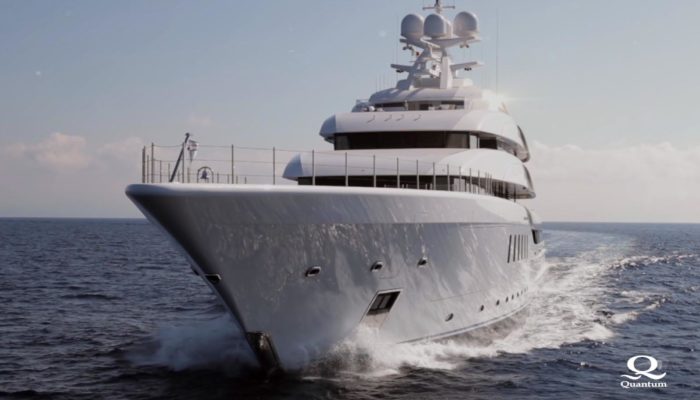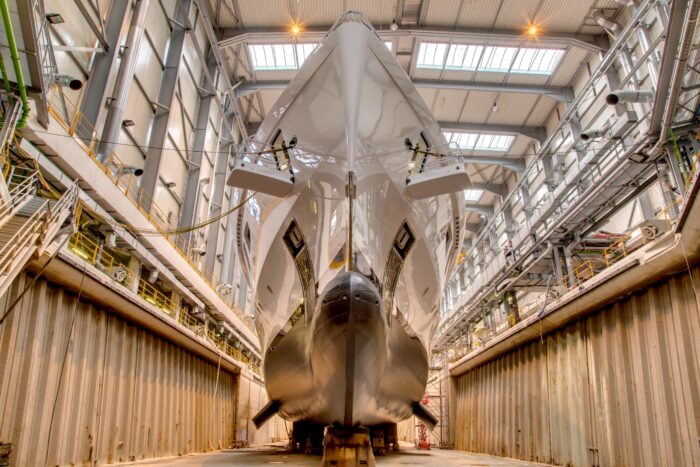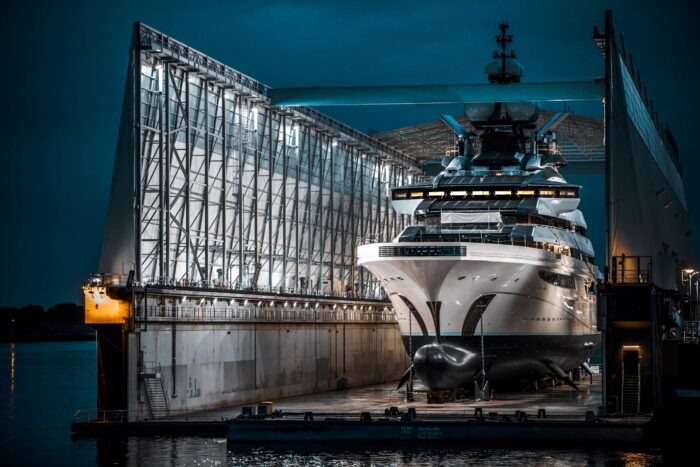How does Yacht Stabilization work?
The first use of a fin stabilizer dates back to 1933 with a Japanese cruise liner. Fin stabilizers are appendages strategically positioned outside the hull in the hull envelope, below the waterline. They are designed in shape and movement to generate lift or downforces that reduce the roll of a vessel. A vessel typically rolls sideways, and the fins oscillate, using opposing movements to negate the roll and stabilize the vessel. The fins are powered either hydraulically, electrically, or pneumatically through a mechanism known as a hull unit, inside the vessel, typically at the turn of the bilge. The stabilizer system is activated by a master controller that directs the power required and the movement of the fins through an algorithm and various motion sensors. Naval Architecture is a discipline that plays a major role in the design, sizing, power, and placement of marine stabilizers.
All about Yacht Stabilization in 2024

What is a yacht stabilizer?
There are various yacht stabilizer systems, including those that are effective while a yacht is underway and/or at zero speed. In the larger boat market, 50m+, yacht stabilizers are typically fins or rotors mounted beneath the waterline, positioned typically amidships, laterally from the hull to reduce the roll of the vessel. There are several types of stabilizers, whereby some are active (with movement underwater) and some are passive (fix, with no movement underwater).

What are the types of stabilizers used on yachts?
There are two primary yacht stabilizer systems: passive and active yacht stabilization systems. Both systems adopt differing marine engineering solutions to minimize roll. Let’s explore the differences.
Passive yacht stabilization systems
A passive system does not require a separate power source, nor does it need a unique control system. Examples of passive stabilization systems and their key elements include bilge keels, passive anti-rolling tanks and fixed fins. With this report, we will only touch on the two most common, bilge keels and anti-roll tanks.
Bilge Keels
Bilge keels are stabilizing fins fixed along the bottom of a yacht’s hull. They reduce rolling motion by increasing hydrodynamic resistance and forcing the water to move with the ship, enhancing stability and comfort, especially in rough seas. A benefit of bilge keels is that they are maintenance-free, making them popular for a wide range of vessels.
Bilge keels are most effective at larger roll angles, and therefore their function is more related to safety than to onboard comfort in low to moderate sea states. They work best at zero or very low speed due to vortex damping and at high speeds due to lifting surfaces.
Passive Anti-Roll Tanks
Anti-roll tanks are specialized compartments partially filled with water and positioned transversally within a yacht, designed in such a way that the water movement counteracts the roll motion, therefore increasing onboard comfort and safety. It can be a single tank with sloshing water (flume tanks) or two-wing tanks connected below the ship “U-type tank.” The later can be made active by opening and closing valves on the right timing or by applying air pressure to both port and starboard tanks. For fully passive types, the tuning of the tank to the ship characteristics is fundamental, and even a well-tuned tank can potentially be detrimental in off-resonant conditions. The active version mitigates these drawbacks, but still requires careful study before placing.
One drawback of anti-roll tanks is that they take up a large amount of space on a vessel, making them less popular when space is at a premium. Furthermore, the increase in displacement & draft, induces drag, negating any benefit when compared to appendage drag from fin stabilizers.
Active yacht stabilization systems
There are various active stabilizer systems available including fins, rotors, gyroscopes and active anti-rolling tanks. With this report, we will only touch on the two most common, active fins and gyroscopes. Unlike a passive system, an active system generates movement to maximize the stability of a vessel. Active systems are more sophisticated and offer higher performance or greater roll reduction than a passive system.
Active Fins
Active fins work by sensing the vessel’s roll motion through a roll sensor that transmits the roll velocity, roll angle and roll acceleration to a main controller. Using customized algorithms and the yacht’s unique roll characteristics, the controller sends the optimal fin movement to the hull unit that drives the fin to the desired angle. The fin motion is driven by either hydraulic or electric actuators. Active fins are a popular solution as they are able to deliver up to 90% reduction in roll, and are often combined with Quantum’s Zero Speed™ technology. Active fin stabilizers, in zero speed mode, use a paddling motion with an opposing force between port and starboard to generate lift.
Gyroscope (Gyro Stabilizer)
Stabilizer gyroscopes go back even earlier than fin stabilizers to the late 1800’s, but the fin-type stabilizer was favored due to the lower cost and lighter weight.
A gyro stabilizer reduces the roll of a vessel using a rapidly spinning flywheel within a vacuum-enclosed sphere. Inside the sphere, the steel flywheel can spin at a rate of approximately 10,000 rpm. When a vessel experiences a roll, the gyro movement is fore and aft (processes) to negate the roll of vessel from port to starboard. Since the forces generated by the gyroscopic effects increase the faster the ship rolls, this system is best suited for ships with short roll periods.
While gyro yacht stabilizers are relatively popular, they do have drawbacks, as the power draw is relatively high on start-up, and are less effective in comparison to fins when a yacht is underway. This is due to the maximum righting force being fixed whereas a fin’s lift force is quadratically linked to the vessel speed. Furthermore, gyros are often a heavier system than fins, thus increasing a yacht’s displacement and hence drag, increasing the fuel consumption. They can also be difficult to service if there is limited space on board. In addition, gyro stabilizers can take 45 – 60 minutes to “ramp up,” whereas other stabilizer solutions are instantaneously functioning.
What is zero speed stabilization?
Zero Speed™ was introduced by Quantum Marine Stabilizers in the year 2000. When a vessel is underway, the flow of water over the fin surface can be used to generate a lift force, creating stabilization, however, when a vessel is at zero speed, there is no flow and no lift force. Vessels are most vulnerable to rolling at slow or zero speeds where the wave encounter can be close to the vessels natural roll period, inducing significant roll motion. Quantum developed an active paddling system with Zero Speed™, a feature or option available on all systems to enhance the cruising experience. This represented groundbreaking technology for the marine industry, allowing yachts to remain stable in rough anchorages and opened the door to yachting for those who previously suffered from seasickness.
How do hydraulics work to power a marine stabilizer?
Many stabilizer systems, especially in the larger boat market 50m+, are powered by hydraulics. Electrical energy is converted to fluid energy (hydraulics) using pumps to create flow and valves to control the pressure and flow. The hydraulic energy is converted into mechanical energy in the hydraulic cylinders that then drive the movement of the fins. The cylinders are connected to the fin by a shaft that extends from inside the vessel, typically at the turn of the bilge, through the hull, and under the waterline. The fin is directed to move according to the detected roll motion from the roll sensor and the system control algorithms, customized to meet the specifications and requirements of the vessel, while also interpreting the actual sea conditions.

Which stabilization system is right for which yacht?
“It is not just about the length of the vessel, but about the requirements, specifications, and how the vessel is intended to be used. An 85m, for example, could use different stabilizer options or a combination of stabilizers. The analysis and performance predictions may find that a MAGLift™ or an XT™ will be well suited for the requirements of the vessel. The next question is, are you going to Monaco or the Antarctic? How many people do you want to take with you? How long do you want to be at sea? What is the comfort level you are looking for?”
John Allen, CEO of Quantum Marine Stabilizers
Though there are many options to consider when analyzing the best stabilizer solution for your needs, it is NOT an “off-the-shelf” item.
Yacht stabilization falls under the domain of naval architecture as there are many calculations and relevant data points to assimilate, such as hydrostatic characteristics:
- Natural roll period
- Vessel speed
- Metacentric height (GM)
- Displacement
- Beam
- Hull form
- Sea state requirements
Naval Architects in the past and today use adaptive and variant design. In other words, using an existing stable design as a starting point and then making revisions as needed. This ensures a successful design versus starting from scratch and taking on new risks. In addition to that practice, Computational Fluid Dynamics (CFD), ship model testing, and advancements in hydrodynamics and structure interaction have been added to the toolbox, offering greater precision to the process of specifying a stabilizer system. Keep in mind that the stabilizer supplier, the shipyard, and an experienced naval architect are excellent resources to help in determining the optimal system, the appropriate size and proper power are best suited for your needs.
The large number of elements involved (naval architecture, hydrodynamics, seakeeping studies, and performance requirements) result in a complex problem for which the solution is necessarily vessel-specific, as no two yachts share the same combination of the above factors.
Do you want to find out more about how yacht stabilization works?
Yacht stabilizer systems offer different technologies, and the system that is right for you will depend on your yacht, desired outcome, budget, and cruising habits.
Quantum’s team of marine stabilization experts today Contact